Silent film
[5] The principle of stroboscopic animation was well-known since the introduction of the phenakistiscope in 1833, a popular optical toy, but the development of cinematography was hampered by long exposure times for photographic emulsions, until Eadweard Muybridge managed to record a chronophotographic sequence in 1878.The work of other pioneering chronophotographers, including Étienne-Jules Marey and Ottomar Anschütz, furthered the development of motion picture cameras, projectors and transparent celluloid film.Although Thomas Edison was keen to develop a film system that would be synchronised with his phonograph, he eventually introduced the kinetoscope as a silent motion picture viewer in 1893 and later "kinetophone" versions remained unsuccessful.Some scholars claim that the artistic quality of cinema decreased for several years, during the early 1930s, until film directors, actors, and production staff adapted fully to the new "talkies" around the mid-1930s.Massive theatre organs, which were designed to fill a gap between a simple piano soloist and a larger orchestra, had a wide range of special effects.Conversely, as benshi-narrated films often lacked intertitles, modern-day audiences may sometimes find it difficult to follow the plots without specialised subtitling or additional commentary.Scores used in current reissues or screenings of silent films may be complete reconstructions of compositions, newly composed for the occasion, assembled from already existing music libraries, or improvised on the spot in the manner of the silent-era theater musician.Although the contemporary score, which included pop songs by Freddie Mercury, Pat Benatar, and Jon Anderson of Yes, was controversial, the door had been opened for a new approach to the presentation of classic silent films.Other purveyors of the traditional approach include organists such as Dennis James and pianists such as Neil Brand, Günter Buchwald, Philip C. Carli, Ben Model, and William P. Perry.Orchestral conductors such as Carl Davis and Robert Israel have written and compiled scores for numerous silent films; many of these have been featured in showings on Turner Classic Movies or have been released on DVD.Donald Sosin and his wife Joanna Seaton specialize in adding vocals to silent films, particularly where there is onscreen singing that benefits from hearing the actual song being performed.Films in this category include Griffith's Lady of the Pavements with Lupe Vélez, Edwin Carewe's Evangeline with Dolores del Río, and Rupert Julian's The Phantom of the Opera with Mary Philbin and Virginia Pearson.This is mainly attributed to the influx of emigrants from the Weimar Republic, "including film directors, producers, cameramen, lighting and stage technicians, as well as actors and actresses".[29] With the lack of natural color processing available, films of the silent era were frequently dipped in dyestuffs and dyed various shades and hues to signal a mood or represent a time of day.This technique was designed to capture the effect of the live performances of Loie Fuller, beginning in 1891, in which stage lights with colored gels turned her white flowing dresses and sleeves into artistic movement.Méliès began hand-tinting his work as early as 1897 and the 1899 Cendrillion (Cinderella) and 1900 Jeanne d'Arc (Joan of Arc) provide early examples of hand-tinted films in which the color was a critical part of the scenography or mise-en-scène; such precise tinting used the workshop of Elisabeth Thuillier in Paris, with teams of female artists adding layers of color to each frame by hand rather than using a more common (and less expensive) process of stenciling.[32] A newly restored version of Méliès' A Trip to the Moon, originally released in 1902, shows an exuberant use of color designed to add texture and interest to the image.[33] Comments by an American distributor in a 1908 film-supply catalog further underscore France's continuing dominance in the field of hand-coloring films during the early silent era.[34] Although the reasons for the cited extra charge were likely obvious to customers, the distributor explains why his catalog's colored films command such significantly higher prices and require more time for delivery.His 1915 epic The Birth of a Nation used a number of colors, including amber, blue, lavender, and a striking red tint for scenes such as the "burning of Atlanta" and the ride of the Ku Klux Klan at the climax of the picture.Actors costumed as cowboys and Native Americans galloped across Scott's movie ranch set, which had a frontier main street, a wide selection of stagecoaches and a 56-foot stockade.[36] Although attempts to create sync-sound motion pictures go back to the Edison lab in 1896, only from the early 1920s were the basic technologies such as vacuum tube amplifiers and high-quality loudspeakers available.The next few years saw a race to design, implement, and market several rival sound-on-disc and sound-on-film sound formats, such as Photokinema (1921), Phonofilm (1923), Vitaphone (1926), Fox Movietone (1927) and RCA Photophone (1928).Sunset Boulevard shows the disconnect between the two eras in the character of Norma Desmond, played by silent film star Gloria Swanson, and Singin' in the Rain deals with Hollywood artists adjusting to the talkies.Peter Bogdanovich's 1976 film Nickelodeon deals with the turmoil of silent filmmaking in Hollywood during the early 1910s, leading up to the release of D. W. Griffith's epic The Birth of a Nation (1915).In 1999, the Finnish filmmaker Aki Kaurismäki produced Juha in black and white, which captures the style of a silent film, using intertitles in place of spoken dialogue.The espionage film The Thief (1952) has music and sound effects, but no dialogue, as do Thierry Zéno's 1974 Vase de Noces and Patrick Bokanowski's 1982 The Angel.[51] The film was shown inside a miniature 12-seat Art Deco movie palace on wheels called The Capitol Theater, created by Oakland, Ca.Set in a small New England town, the story centers on Oliver Henry III (played by Westerly native Geoff Blanchette), a small-time crook turned vaudeville theater owner.[63][64] Works by Pearl White, Helen Holmes, Grace Cunard, Lois Weber, Harold Lloyd, Douglas Fairbanks, and Lon Chaney, among others, were included, as well as many newsreels.
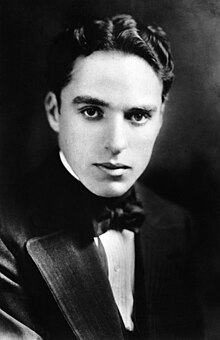




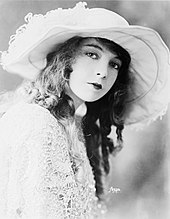
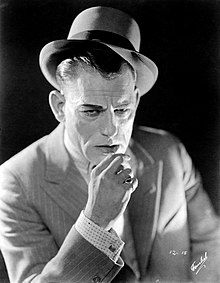
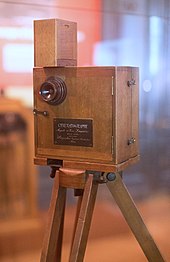


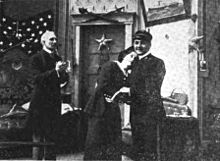
Silent MovieA Silent FilmThe Four Horsemen of the ApocalypseCharlie Chaplinrecorded sounddialoguenarrativetitle cardspianisttheater organistorchestrasheet musicimprovisationCity LightsModern TimesretronymThe Jazz Singer"talkies", "sound films", or "talking pictures"phonographAudion amplifier tubeVitaphonesound erasound effectsPrecursors of filmHistory of film technologyEadward MuybridgeThe Horse in MotionRoundhay Garden SceneSarah WhitleyLouis Le Princemagic lanternphotographsanimationphenakistiscopeoptical toycinematographyphotographic emulsionsEadweard MuybridgechronophotographiczoetropeszoopraxiscopeÉtienne-Jules MareyOttomar AnschützThomas EdisonkinetoscopeEdison StudiosBattle of Chemulpo BayIncheon1894 in film1929 in film1910s in filmClassical HollywoodFrench ImpressionismGerman ExpressionismSoviet Montageclose-uplong shotpanningcontinuity editingtalking picturesfilm directorsAziza Amircensorship cutscritical flicker frequencyfilm tintingtoningKinemacolorTechnicolorsound-on-filmThe Cabinet of Dr. Caligariinter-titlesKoster and Bial's Music Hallorganiststheatre organsMusical scoresimprovisedphotoplay musicmovie studioJoseph Carl BreilD. W. GriffithThe Birth of a NationCamille Saint-SaënsThe Assassination of the Duke of GuiseMikhail Ippolitov-IvanovStenka RazinGreat Depressioncinema of Braziloperettasbenshimusicologistsrepertory cinemasKevin BrownlowAbel GanceNapoléonCarl DavisFrancis Ford CoppolaCarmine CoppolaMetropolisGiorgio MoroderFreddie MercuryPat BenatarJon AndersonGaylord CarterDennis JamesNeil BrandBen ModelWilliam P. PerryRobert IsraelTurner Classic MoviesThe Big ParadeFlesh and the DevilHarold LloydBuster KeatonCharley ChaseTimothy BrockUn Drame Musical InstantanéAlloy OrchestraClub Foot OrchestraSilent OrchestraRPM OrchestraLady of the PavementsLupe VélezEdwin CareweEvangelineDolores del RíoRupert Julian